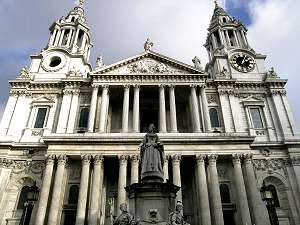I have been fascinated by buildings and structures since my early youth. I would grab paper and a pencil and escape by creating new worlds full of buildings and houses, I've designed a new dream house for myself already at least a half dozen times. Time escapes me when I sit down and sketch a beautiful building. All architects are unique, but all share the same love and fascination with creating and shaping the world around them.
 |
| I'm currently working on a sketch of St. Pauls Cathedral... it is super hard Isn't it a beauty, though? |
Communication is an integral part of the profession of architecture. Every day architects collaborate with other architects, structural engineers, building contractors, electrical engineers, surveyors, and every other profession that has to do with erecting any type of structure; but the most important communication that occurs in the profession is with the client. The client is who provides the resources you need to create something, his needs and desires must be met. Unfortunately, the majority of clients don't know all that much about architecture, and are usually more worried about cost than anything else. So they want the best product for the cheapest price, it's basic economics. If an architect is a skilled rhetorician, he can better provide the vision he sees in his own mind to the client. Without any communication skills, an architect would be useless. He would be unable to share any plans or any ideas. Architects communicate through many means; they speak on the phone, through e-mail, in meetings, they build models and draw sketches to communicate their ideas visually.
 |
| What messages does the church communicate through its' architecture? |
Perhaps the most powerful communication tool for an architect are his designs themselves. It takes a great deals of interpersonal skills to get a project going and to keep it going through the design process, but what the finished product ends up being is a strong message from the Architect. It is the architects message to the world and community around him or her. Sometimes it is hard to find the message they are sending, perhaps their communication skills weren't the best so they weren't able to get what they wanted in the design process, so their idea and vision may have been polluted by cost restrictions and client demands. But an architect who knows how to communicate and persuade will, in the end, send beautiful and powerful messages through their creations.
Most of the knowledge that I've gained about architecture have come from practical experience, I've done an extended internship at an architecture firm in Salt Lake City, and was also an Architecture major at the University of Utah before I went on my mission and transferred to BYU.

Before reading this, I imagined architecture to be a very solitary and individual art. I never would have imagined that so much communication and rhetoric could be used. It was fascinating to gain this new understanding. You did a good job adding all the elements to the assignment. I'd like to hear more specifics about why you chose architecture. I understand that you have been interested in in for a while, but why? Why not just doodling or other forms of art?
ReplyDeleteYeah, a lot of times the most famous architects can seem very individualistic because their buildings are so unique and people can usually tell when, for example, a building was designed by Frank Lloyd Wright. But that's because their ethos has been so magnified out of fame that when a client goes to them they simply give them what they need and let the famous architect do pretty much whatever they want, already knowing that it'll be expensive. But they'll pay the price because their building will be famous.
DeleteIt's pretty tacky to say, but I feel less like I've chosen architecture and more like architecture has chosen me. Does that make sense? In high school I always wanted to be a doctor. But for all the wrong reasons. I liked the pay check and the respect automatically given to one with an M.D. after their name. (Who wouldn't?) Sometimes I still try to talk myself out of being an architect because there are easier options, but I always return back to architecture. I've never liked drawing anything other than buildings. I don't have enough interest in any other forms of art to make a career out of them.
Your blog post was very fascinating to me. I really liked how you brought the interpretation process that the architect uses to portray his vision on paper. I had a layover in Dubai and was able to see the world's tallest building when it was in construction. It is beautiful, and it really intrigued me and I had gained a respect for those who designed it.
ReplyDelete